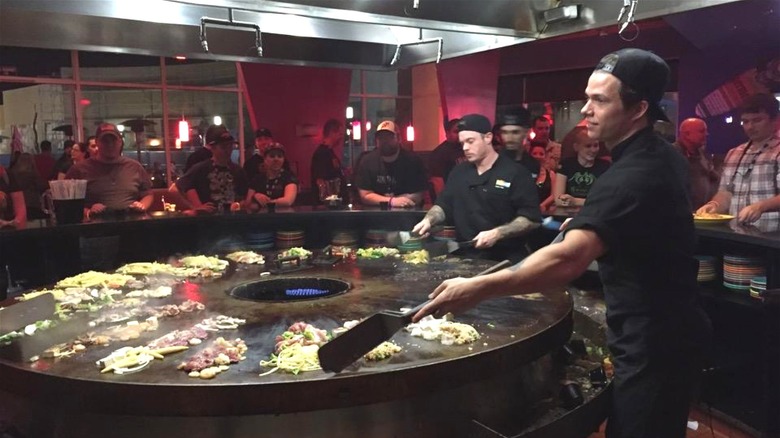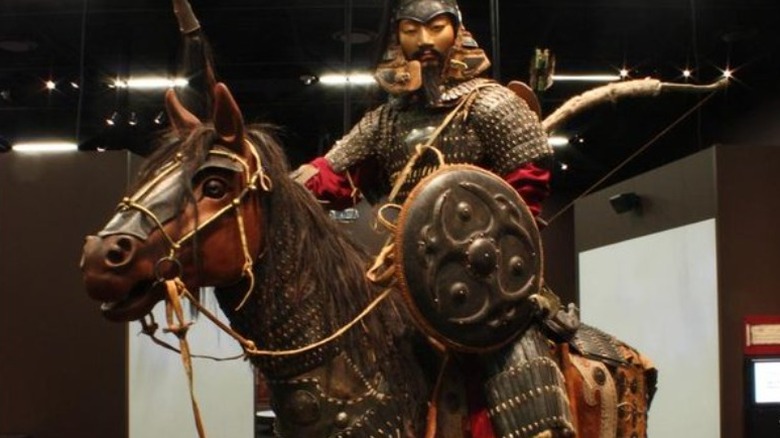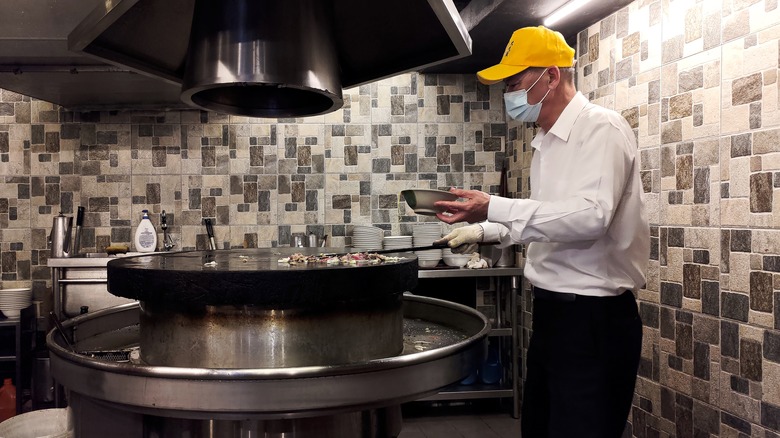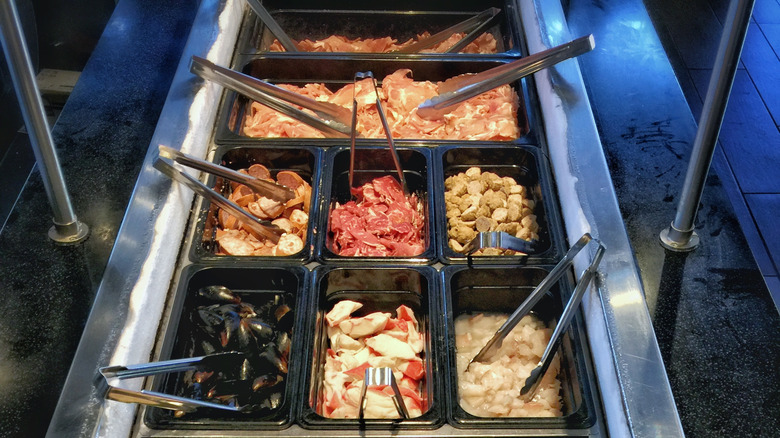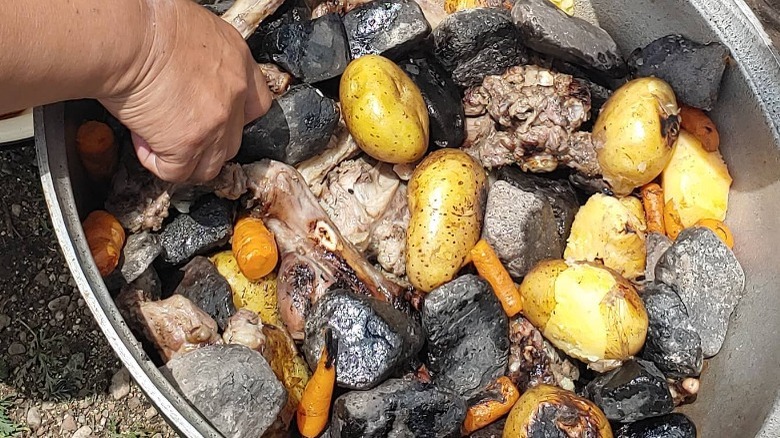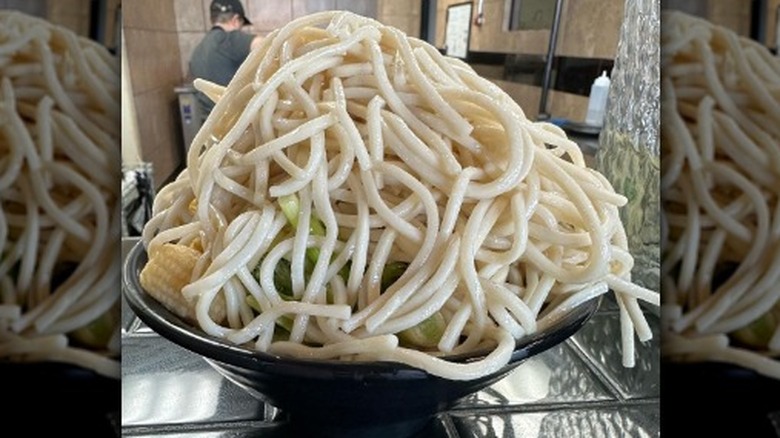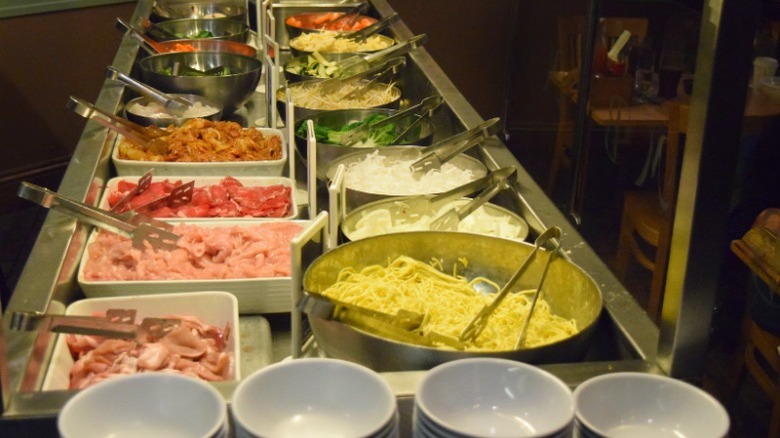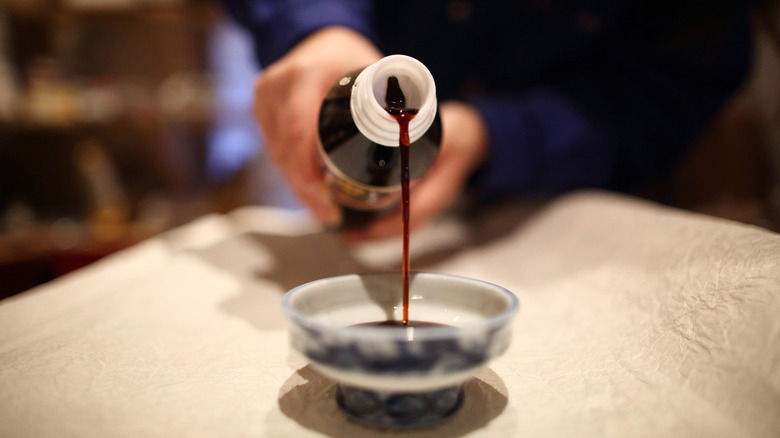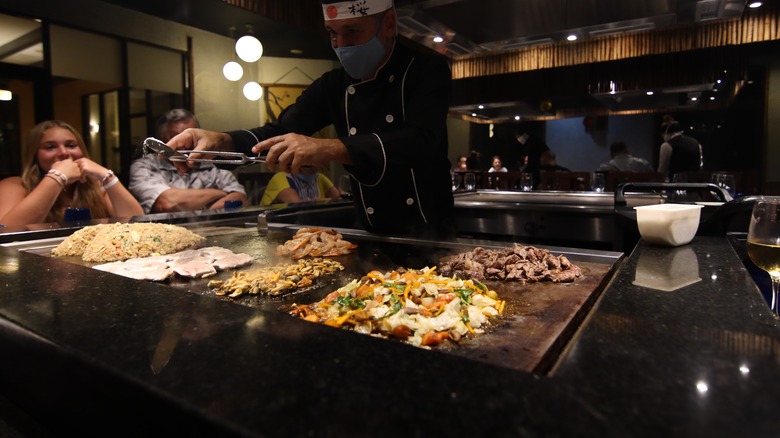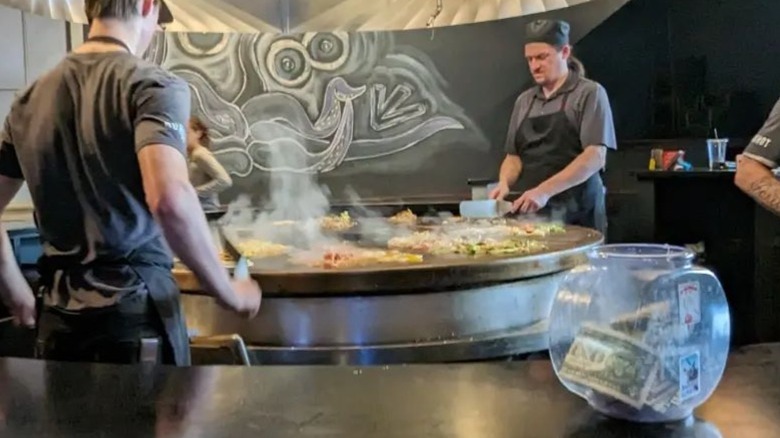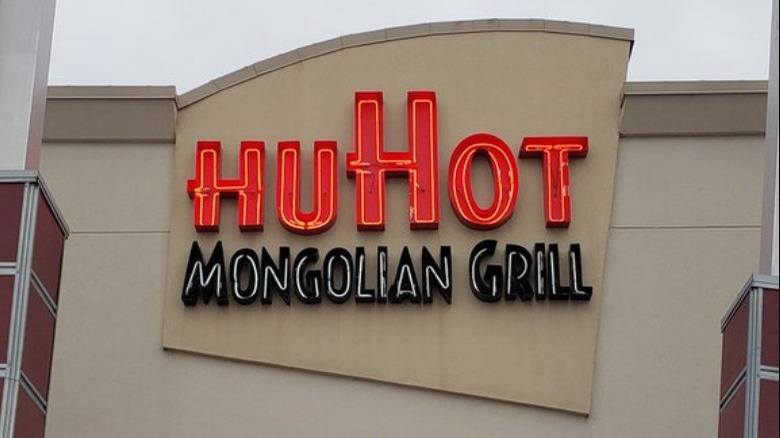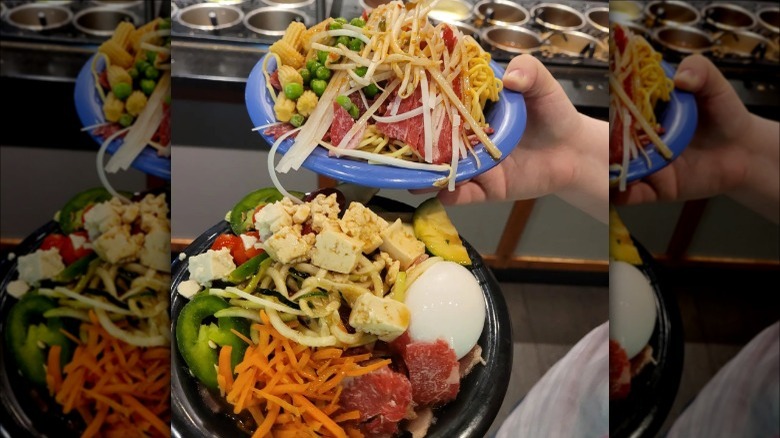What You Should Know Before You Eat Mongolian Barbecue
Mongolian barbecue is a foodie's dream. This interactive dining experience allows you to choose your own ingredients and then have a Mongolian barbecue master cook them for you. You could technically label it as fast food since it takes mere minutes to cook. However, all the fresh ingredients make it a healthy eating option (as long as you don't add too many unhealthy sauces).
Contrary to the legend that attributes Mongolian barbecue's creation to Mongolian warriors from the era of Genghis Khan, the dish did not originate in Mongolia. Here, we've dispelled a common legend surrounding this dish and traced its true history. We've also uncovered valuable information for both novice and long-time eaters of the dish, like the proper way to stack your ingredients in your bowl to get the most value for your dollar. You'll also learn how to avoid ruining your next Mongolian barbecue meal. Join us as we uncover everything you need to know before you go out for Mongolian barbecue.
The Mongolian warrior backstory is complete hogwash
A lot of restaurants like to make a hard sell on a Mongolian barbecue backstory that has no basis in reality. The story goes that Mongolian barbecue originated with Mongolian warriors who needed a way to cook their food while fighting for Genghis Khan. So, being a resourceful bunch, they put their shields over a hot fire and used them to cook their meat and other ingredients. Some Mongolian barbecue places go as far as to put huge iron shields on their walls to sell the idea. We're not sure who started this legend, but it's an impossible one.
It turns out that only a small portion of Mongolian warriors used shields, and they weren't made from metal. Imagine riding a horse all day with a metal shield, and you'll understand why the Mongols made them from hard leather and wicker instead of iron. Now, imagine grilling up your Mongolian barbecue on a wicker and leather shield. You'd only cook your food on that shield once and then have no shield left to defend yourself. So, it's fairly obvious that someone made up the whole Mongolian warrior backstory for Mongolian barbecue to make it sound cooler.
Mongolian barbecue isn't even from Mongolia
Mongolian barbecue actually got its start about 1,800 miles away from Mongolia in Taipei, Taiwan. So, it's really Taiwanese cuisine rather than Mongolian cuisine. Interestingly, the man who invented Mongolian barbecue, Wu Zhao-nan, was best known as a comedian. He was skilled at crosstalk – a popular Chinese conversational-style comedic form focusing on social issues. Wu was originally from China, so Mongolian barbecue's place at Chinese buffets definitely fits. However, he was living in Taiwan when he invented Mongolian barbecue. He fled to Taiwan in 1949 and, two years later, he built a tea shop in Taipei. He quickly added food options to the establishment, serving meat and vegetables cooked on a large iron plate with a choice of nine sauces. He named the spot Barbecue Fragrance.
For political reasons, Wu knew he couldn't name his barbecue Beijing Barbecue (which was his first choice) to honor his hometown, so he decided to call it "mong gu kao rou" (Mongolian barbecue) instead. He started out trying to sell it for about $3 NT but didn't see success until he began offering it as all-you-can-eat barbecue for $1 NT. Thus, the all-you-can-eat option was born in Taiwan. Mongolian barbecue became so popular that even important diplomats and CEOs were eating there. Eventually, other entrepreneurs pounced on the idea of opening up similar restaurants for themselves.
Floods, fires, and pandemics brought down the oldest Mongolian barbecue locations
The original Barbecue Fragrance location was decimated when a typhoon came through Taipei and flooded the building. Wu's barbecue was popular, so it wasn't long before there was an offer of a new place for him to set up shop with his barbecue business. His second location was on the top floor of a hotel, where he could serve both his regular customers and hotel guests. Yet, disaster struck again when his hotel-top restaurant caught on fire. With two major disasters under his belt, Wu thought it better to focus on being a crosstalk comedian, a profession that ultimately brought him renown and many awards in Taiwan.
There have been plenty of imitators selling Mongolian barbecue in Taiwan. The one believed to have endured longest was a beloved restaurant called Genghis Khan Mongolian Bar-B-Q, which opened in 1963 – 12 years after Barbecue Fragrance paved the way. Unfortunately, after a six-decade run, Genghis Khan Mongolian Bar-B-Q found itself unable to pay rent. After months of struggling with indoor dining bans during the COVID-19 pandemic, it finally announced it would close its doors forever. The announcement came on August 2, 2021, and the indoor dining bans were lifted the next day. Sadly, it was too late — the damage of months without customers was irreversible.
Mongolian barbecue made it to America before its inventor did
The man responsible for bringing Mongolian barbecue to the U.S. wasn't Wu. However, it was someone who was born in China and had sought refuge in Taiwan after the Communist revolution, like Wu had. John C. Lee moved to the U.S. in 1966 with the intention of opening up a whole chain of Mongolian barbecue restaurants. He called his restaurant chain Colonel Lee's Mongolian BBQ, since he had been a colonel in Taiwan's Republic of China army. Californians first experienced Mongolian barbecue through his restaurant chain in 1969. The first restaurant was in Northridge, California. Knowing Mongolian BBQ would become immensely popular, Lee decided he wanted to profit from other entrepreneurs' ventures and started making and selling Mongolian barbecue grills.
Wu didn't follow his culinary invention to the U.S. until 1973 — five years after the first Mongolian barbecue restaurant opened on American soil. He initially came to southern California to be a crosstalk comedian. However, rather than continuing to dabble in his signature dish, he created and sold Chinese-style beef jerky, since the U.S. version didn't suit him. Chinese Brand Beef Jerky is still popular among Asian Americans and comes in some flavors you don't usually see in U.S. jerky, like fruit, hot fruit, and curry.
Mongolians have their own style of barbecue called khorkhog
Lest you think Mongolians don't barbecue, they do. It just doesn't look like the type of barbecue you find in Mongolian barbecue restaurants, and it's called "khorkhog." Khorkhog is one of those dishes Mongolians make for special occasions, so you're likely to experience it at a Mongolian family get-together or wedding. This one-pot dish requires hot rocks, a huge covered pot, lots of meat (like lamb or goat), and vegetables. Meat gets layered into the pot, along with water, fire-heated river stones, and vegetables like onions, carrots, and potatoes. Rutabagas are also essential since they're a big part of Mongolian cuisine. Spices like garlic, pepper, and bay leaves bring out the flavors of the ingredients.
The tradition of putting hot rocks in khorkhog comes from a much earlier Mongolian hunters' dish called "boodog." The hunters would cook animal meat inside a bag made from the animal's skin. Boodog would cook over a fire, but hot rocks inside the bag would speed the process along and give you an end product that was both steamed and seared, like khorkhog. There are a few places that serve khorkhog if you don't know of a Mongolian party you can crash. One such place is Dumpling House Mongolian Cuisine in Richmond, California. However, because of the long cooking time, you'll want to order a couple of hours ahead of when you actually plan to eat.
There's an art to stacking your ingredients
If you're paying by the bowl rather than an all-you-can-eat price, you want to get as many ingredients into your bowl as possible since the ingredients will cook down smaller. It's easier if you go to a place that provides a plate instead of a bowl. But if you are trying to get as many ingredients as possible into a tiny bowl, it's essential to make a stacking strategy. If your restaurant provides waxed paper with your bowl, you can use it to press down the ingredients between layers to keep your hands clean.
You'll definitely want to put denser items like frozen meat at the bottom of the bowl. Then, you should add the sauce on top of the meat, which will soften some of the more awkward chunks to make room for more ingredients. You can fortify and increase the height of the bowl by adding tall ingredients along the sides. Your ingredient wall could be anything from long pieces of frozen meat to large vegetable slices. All your veggies and fruits go next. Finally, you'll heap your noodles or rice on top. Look for noodles or rice that are already clumped together so that you know your tower of ingredients will stay intact as you carefully walk it over to the grill, hoping not to spill anything.
The ingredients in Mongolian barbecue are up to you
Mongolian barbecue is an interactive dining experience that allows you to be a culinary artist with the bowl serving as your canvas. When you walk up to the Mongolian barbecue station, you will find an array of ingredients and sauces to add to your bowl. The beauty of Mongolian barbecue is that you can choose the same ingredients every time or mix them up so that no two meals are ever the same.
You never know which ingredients you'll find when you walk into a Mongolian barbecue place for the first time. However, the standards are meat, veggies, carbs, and sauces. Thinly-sliced meat usually starts out frozen or chilled and can include raw or cooked meats ranging from chicken, seafood, or beef. At HuHot Mongolian Grill, you'll even find options like meatballs or breaded chicken. Then, you have a choice of pre-cooked rice or noodles. Some places may even offer zucchini noodles for people who are on a low-carb diet.
The veggie selection varies from place to place and may include selections like cabbage, broccoli, peppers, and onions. You may even see some fruits like mandarin oranges and pineapples or extra protein sources like tofu, peas, and beans. Sauces vary and may include simple items like broth, sesame oil, soy sauce, and chili oil. However, you're also likely to encounter distinct house-created specialty offerings, like curry-flavored or teriyaki-flavored sauces.
You shouldn't go overboard on sauce
It's tempting to see 20 types of sauce and want to add a little of everything. However, there's definitely a hard limit. Adding too much sauce can overwhelm the dish and end up ruining your masterpiece. For example, if you add too much soy sauce, the dish might end up being too salty for your taste, or you can end up mixing up a bad flavor combination from adding too many sauces at once. We have a few hints and tips that will help you get the balance right.
If you can find a small bowl to use, you can mix the sauces together and taste the resulting sauce to get an idea of whether you will like it or not. Plus, it allows for better portion control than dumping multiple sauces into your bowl willy-nilly. Some places like HuHot have recipe cards that can give you an idea of which sauces taste good together and how much to use. For example, you may be able to get away with several spoonfuls of house-created sauces, but you'll only need one spoonful or even just a half spoonful of stronger ingredients like garlic oil, hot chili oil, or sesame oil. In some restaurants, it's also possible to give the chef a bowlful of the sauce you want and ask them to add the correct amount if you're feeling doubtful about your ability to eyeball it yourself.
Mongolian barbecue may have been inspired by a Japanese cooking style
There's a possibility that the Mongolian barbecue grilling process was inspired by a Japanese cooking style called teppanyaki. Once you have crammed your bowl full of a multitude of tasty Mongolian barbecue ingredients, you hand them off to a Mongolian barbecue chef to cook them on a blazing hot cast iron grill before your eyes. These gas grills reach temperatures between 550 and 650 degrees Fahrenheit, allowing the chef to cook your food in mere minutes. This cooking process is not unlike the teppanyaki cooking process.
Misono in Kobe, Japan, claims it was the first teppanyaki restaurant, and it didn't open until the end of World War II in 1945. The story goes that the restaurant started out serving okonomiyaki (Japanese pancakes) on a large, salvaged iron plate. However, when an American soldier came in looking for a meat dish, the chef cooked beef for him on the iron plate instead, inspiring teppanyaki.
Teppanyaki turned cooking ingredients in front of its customers into a performance culinary art. It also became popular in Taiwan, so you will see rumors that the Mongolian grilling process on a large iron surface takes inspiration from teppanyaki. However, since Wu Zhao-nan created Mongolian barbecue in 1951, and teppanyaki wasn't popular in Taiwan until the 1970s, the similarities may simply be coincidental. Of course, there's always the possibility that Wu may have heard about teppanyaki or experienced it in the years before moving to Taiwan.
You should tip your Mongolian barbecue chef if they have a tip jar
That tip jar in front of a Mongolian barbecue chef can be daunting, especially if you don't carry cash. However, if you see a tip jar in front of your Mongolian barbecue chef, you'll know they are hoping for a tip. If you're eating in a buffet-style environment, it's not uncommon to tip the wait staff less. The common tipping amount at a buffet is closer to 10% than the 15% to 20% you're likely to spend at a full-service restaurant. You collect your own food in both a buffet and in a Mongolian grill environment, so a full tip isn't expected. After all, the chef should be getting a salary rather than working for tips. But if there is a tip jar, it may indicate that the chef's salary isn't terribly high. So, putting a few dollars in the jar is a kind gesture.
There are a few chain restaurants for Mongolian barbecue
Two of the most well-known Mongolian barbecue restaurant chains are HuHot and Genghis Grill. HuHot has around 60 locations in 17 different states. If you're not exactly sure how to build the perfect bowl from the nearly 80 ingredients, you can borrow a cheat sheet recipe. HuHot offers recipes for categories ranging from gluten-free and vegetarian to low-calorie or even contest winners. Genghis Grill first opened in Dallas, Texas in 1998 and has around 45 locations in 14 states. Genghis Grill has over 80 ingredients and even has some specific bowls you can order if you're not feeling confident in your creativity or just want to see what's possible.
There are also some smaller chains. BD's Grill is a newer Mongolian barbecue restaurant that has only been around since 2017. It got its start in Dallas, Texas, and has 16 locations in seven states. Since it's an Asian fusion restaurant, you can choose bowls from the main menu that take inspiration from countries like Thailand, Hong Kong, Japan, Korea, and China. Like HuHot and Genghis Grill, the restaurant has over 80 ingredients you can use to create your own unique bowl. Meanwhile, there are a few local chains such as Great Khan's, which has seven locations in California. Great Khan's has been grilling up customer barbecue creations since 1997. After you fill up a bowl with fresh ingredients and sauces, the chef will cook it for you on an iron grill.
Mongolian barbecue is great for specialized diets
If you have special dietary needs and are with a group that wants to go to a Chinese buffet, you should suggest one that offers Mongolian barbecue. You can't always guess what ingredients are in Chinese buffet menu items. However, constructing your own dish for the Mongolian grill ensures you know exactly what is in your food. So, people who want to eat vegetarian, vegan, keto, or need to adhere to special dietary restrictions like low-carb, gluten-free, or allergen-free can be in control of their own intake.
Because you're able to see each ingredient before you put it in your bowl, you'll know exactly what you're eating. However, you may want to check with the waiter to make sure any marinated meat or sauces don't contain any allergens. When in doubt, stick with plain sauces like sesame oil. If you end up skipping soy sauce or other sauces that may contain soy sauce, you may need to add a little extra salt to bring out the flavor of the ingredients. And you can always ask the chef to clean off the grill and utensils between customers to avoid cross-contamination with allergens.
